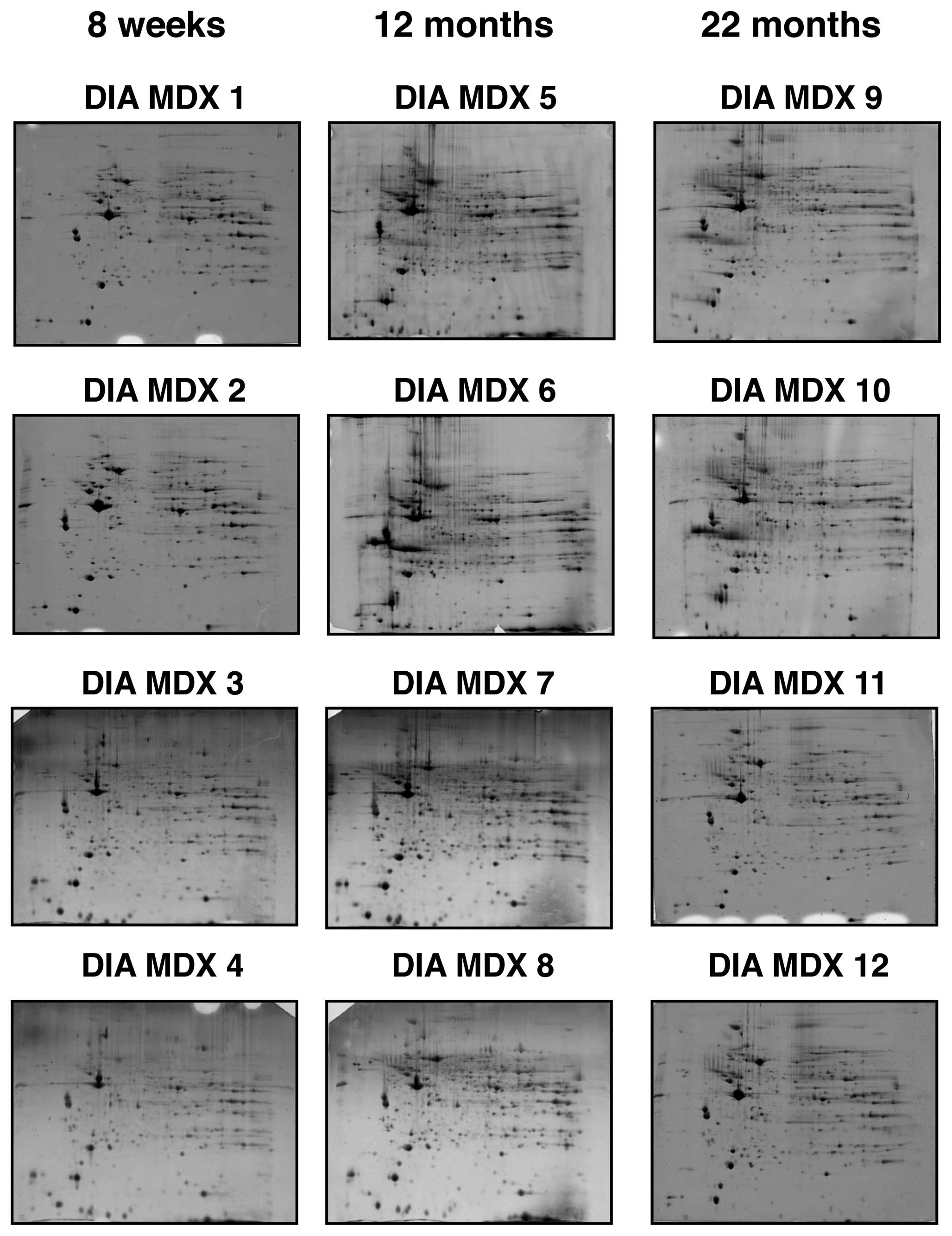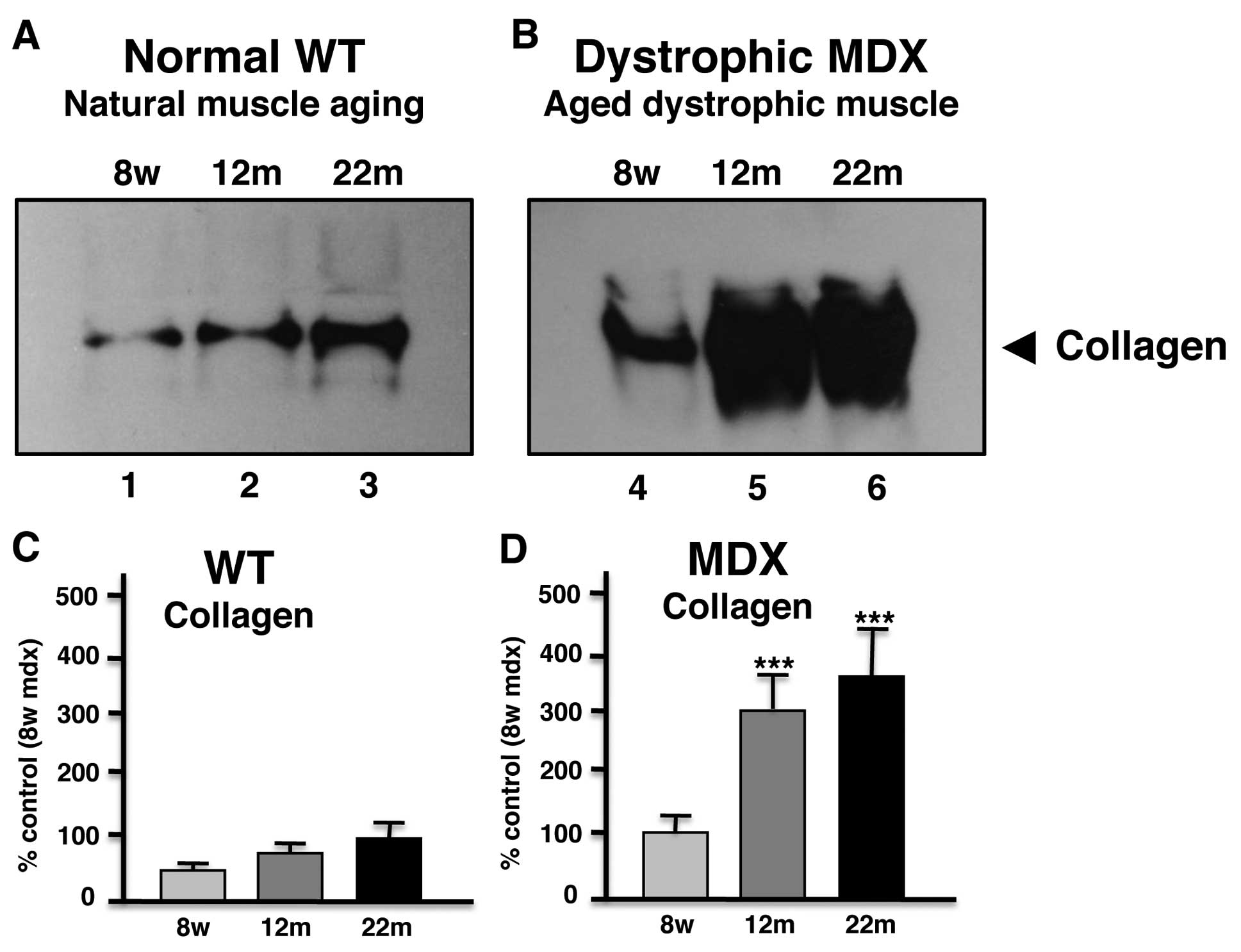|
1.
|
E Le RumeurSJ WinderJF HubertDystrophin:
more than just the sum of its partsBiochim Biophys
Acta180417131722201020472103
|
|
2.
|
K BushbyR FinkelDJ BirnkrantLE CasePR
ClemensL CripeA KaulK KinnettC McDonaldS PandyaDiagnosis and
management of Duchenne muscular dystrophy, part 1: diagnosis, and
pharmacological and psychosocial managementLancet
Neurol97793201010.1016/S1474-4422(09)70271-619945913
|
|
3.
|
M DurbeejKP CampbellMuscular dystrophies
involving the dystrophin-glycoprotein complex: an overview of
current mouse modelsCurr Opin Genet
Dev12349361200210.1016/S0959-437X(02)00309-X12076680
|
|
4.
|
P SicinskiY GengAS Ryder-CookEA BarnardMG
DarlisonPJ BarnardThe molecular basis of muscular dystrophy in the
mdx mouse: a point
mutationScience24415781580198910.1126/science.26624042662404
|
|
5.
|
K OhlendieckKP
CampbellDystrophin-associated proteins are greatly reduced in
skeletal muscle from mdx miceJ Cell
Biol11516851694199110.1083/jcb.115.6.16851757468
|
|
6.
|
G BulfieldWG SillerPA WightKJ MooreX
chromosome-linked muscular dystrophy (mdx) in the mouseProc Natl
Acad Sci USA8111891192198410.1073/pnas.81.4.11896583703
|
|
7.
|
MJ MarquesR FerrettiVU VomeroE MinatelHS
NetoIntrinsic laryngeal muscles are spared from myonecrosis in the
mdx mouse model of Duchenne muscular dystrophyMuscle
Nerve35349353200710.1002/mus.2069717143878
|
|
8.
|
LF TorresLW DuchenThe mutant mdx:
inherited myopathy in the mouse. Morphological studies of nerves,
muscles and
end-platesBrain110269299198710.1093/brain/110.2.2693567525
|
|
9.
|
HH StedmanHL SweeneyJB ShragerHC MaguireRA
PanettieriB PetrofM NarusawaJM LeferovichJT SladkyAM KellThe mdx
mouse diaphragm reproduces the degenerative changes of Duchenne
muscular dystrophyNature352536539199110.1038/352536a01865908
|
|
10.
|
A MenkeH JockuschDecreased osmotic
stability of dystrophin-less muscle cells from the mdx
mouseNature3496971199110.1038/349069a01985268
|
|
11.
|
GS LynchJA RafaelJS ChamberlainJA
FaulknerContraction-induced injury to single permeabilized muscle
fibers from mdx, transgenic mdx, and control miceAm J Physiol Cell
Physiol279C1290C1294200011003610
|
|
12.
|
DG AllenOL GervasioEW YeungNP
WhiteheadCalcium and the damage pathways in muscular dystrophyCan J
Physiol Pharmacol888391201020237582
|
|
13.
|
N MalloukV JacquemondB AllardElevated
subsarcolemmal Ca2+ in mdx mouse skeletal muscle fibers
detected with Ca2+-activated K+ channelsProc
Natl Acad Sci USA97495049552000
|
|
14.
|
TA PartridgeJE MorganGR CoultonEP
HoffmanLM KunkelConversion of mdx myofibres from
dystrophin-negative to -positive by injection of normal
myoblastsNature337176179198910.1038/337176a02643055
|
|
15.
|
DJ WellsKE WellsGene transfer studies in
animals: what do they really tell us about the prospects for gene
therapy in DMD?Neuromuscul
Disord12S11S22200210.1016/S0960-8966(02)00077-912206790
|
|
16.
|
P DoranSD WiltonS FletcherK
OhlendieckProteomic profiling of antisense-induced exon skipping
reveals reversal of pathobiochemical abnormalities in dystrophic
mdx
diaphragmProteomics9671685200910.1002/pmic.20080044119132684
|
|
17.
|
CF SpurneyH Gordish-DressmanAD GuerronA
SaliGS PandeyR RawatJH Van Der MeulenHJ ChaEE PistilliTA
PartridgePreclinical drug trials in the mdx mouse: assessment of
reliable and sensitive outcome measuresMuscle
Nerve39591602200910.1002/mus.2121119260102
|
|
18.
|
TA PartridgeImpending therapies for
Duchenne muscular dystrophyCurr Opin
Neurol24415422201110.1097/WCO.0b013e32834aa3f121892079
|
|
19.
|
JP LefaucheurC PastoretA SebillePhenotype
of dystrophinopathy in old mdx miceAnat
Rec2427076199510.1002/ar.10924201097604983
|
|
20.
|
GS LynchRT HinkleJS ChamberlainSV BrooksJA
FaulknerForce and power output of fast and slow skeletal muscles
from mdx mice 6–28 months oldJ Physiol535591600200111533147
|
|
21.
|
C PastoretA SebilleAge-related differences
in regeneration of dystrophic (mdx) and normal muscle in the
mouseMuscle Nerve1811471154199510.1002/mus.8801810117659109
|
|
22.
|
C PastoretA SebilleMDX mice show
progressive weakness and muscle deterioration with ageJ Neurol
Sci12997105199510.1016/0022-510X(94)00276-T7608742
|
|
23.
|
MA WineingerRT AbreschSA WalshGT
CarterEffects of aging and voluntary exercise on the function of
dystrophic muscle from mdx miceAm J Phys Med
Rehabil772027199810.1097/00002060-199801000-000049482375
|
|
24.
|
SI HeadBranched fibres in old dystrophic
mdx muscle are associated with mechanical weakening of the
sarcolemma, abnormal Ca2+ transients and a breakdown of
Ca2+ homeostasis during fatigueExp
Physiol95641656201010.1113/expphysiol.2009.05201920139167
|
|
25.
|
JS ChamberlainJ MetzgerM ReyesD TownsendJA
FaulknerDystrophin-deficient mdx mice display a reduced life span
and are susceptible to spontaneous rhabdomyosarcomaFASEB
J2121952204200710.1096/fj.06-7353com17360850
|
|
26.
|
A IrintchevM ZweyerA WernigImpaired
functional and structural recovery after muscle injury in
dystrophic mdx miceNeuromuscul
Disord7117125199710.1016/S0960-8966(96)00422-19131653
|
|
27.
|
E MouiselA VignaudC HourdeG Butler-BrowneA
FerryMuscle weakness and atrophy are associated with decreased
regenerative capacity and changes in mTOR signaling in skeletal
muscles of venerable (18–24-month-old) dystrophic mdx miceMuscle
Nerve41809818201020151467
|
|
28.
|
P DoranG MartinP DowlingH JockuschK
OhlendieckProteome analysis of the dystrophin-deficient MDX
diaphragm reveals a drastic increase in the heat shock protein
cvHSPProteomics646104621200610.1002/pmic.20060008216835851
|
|
29.
|
C LewisH JockuschK OhlendieckProteomic
profiling of the dystrophin-deficient MDX heart reveals drastically
altered levels of key metabolic and contractile proteinsJ Biomed
Biotechnol2010648501201010.1155/2010/64850120508850
|
|
30.
|
C LewisK OhlendieckProteomic profiling of
naturally protected extraocular muscles from the
dystrophin-deficient mdx mouseBiochem Biophys Res
Commun39610241029201010.1016/j.bbrc.2010.05.05220471957
|
|
31.
|
T RabilloudJM StrubS LucheA van
DorsselaerJ LunardiA comparison between Sypro Ruby and ruthenium II
tris (bathophenanthroline disulfonate) as fluorescent stains for
protein detection in
gelsProteomics1699704200110.1002/1615-9861(200104)1:5%3C699::AID-PROT699%3E3.0.CO;2-C11678039
|
|
32.
|
J GannonL StauntonK O'ConnellP DoranK
OhlendieckPhosphoproteomic analysis of aged skeletal muscleInt J
Mol Med2233422008
|
|
33.
|
M VainzofD Ayub-GuerrieriPC OnofrePC
MartinsVF LopesD ZilberztajnLS MaiaK SellLU YamamotoAnimal models
for genetic neuromuscular diseasesJ Mol
Neurosci34241248200810.1007/s12031-007-9023-918202836
|
|
34.
|
JL GuenetAnimal models of human genetic
diseases: do they need to be faithful to be useful?Mol Genet
Genomics286120201110.1007/s00438-011-0627-y21547562
|
|
35.
|
GB BanksJS ChamberlainThe value of
mammalian models for duchenne muscular dystrophy in developing
therapeutic strategiesCurr Top Dev
Biol84431453200810.1016/S0070-2153(08)00609-119186250
|
|
36.
|
C LewisS CarberryK OhlendieckProteomic
profiling of X-linked muscular dystrophyJ Muscle Res Cell
Motil30267269200910.1007/s10974-009-9197-620082121
|
|
37.
|
Y GeMP MolloyJS ChamberlainPC
AndrewsProteomic analysis of mdx skeletal muscle: Great reduction
of adenylate kinase 1 expression and enzymatic
activityProteomics318951903200310.1002/pmic.20030056114625851
|
|
38.
|
P DoranP DowlingJ LohanK McDonnellS
PoetschK OhlendieckSubproteomics analysis of
Ca2+-binding proteins demonstrates decreased
calsequestrin expression in dystrophic mouse skeletal muscleEur J
Biochem271394339522004
|
|
39.
|
D Gardan-SalmonJM DixonSM LonerganJT
SelsbyProteomic assessment of the acute phase of dystrophin
deficiency in mdx miceEur J Appl
Physiol11127632773201110.1007/s00421-011-1906-321409400
|
|
40.
|
P DoranP DowlingP DonoghueM BuffiniK
OhlendiecReduced expression of regucalcin in young and aged mdx
diaphragm indicates abnormal cytosolic calcium handling in
dystrophin-deficient muscleBiochim Biophys
Acta1764773785200610.1016/j.bbapap.2006.01.007
|
|
41.
|
MK GulstonDV RubtsovHJ AthertonK ClarkeKE
DaviesKS LilleyJL GriffinA combined metabolomic and proteomic
investigation of the effects of a failure to express dystrophin in
the mouse heartJ Proteome
Res720692077200810.1021/pr800070p18386883
|
|
42.
|
TW KragstrupM KjaerAL MackeyStructural,
biochemical, cellular, and functional changes in skeletal muscle
extracellular matrix with agingScand J Med Sci
Sports21749757201110.1111/j.1600-0838.2011.01377.x22092924
|
|
43.
|
G GoldspinkK FernandesPE WilliamsDJ
WellsAge-related changes in collagen gene expression in the muscles
of mdx dystrophic and normal miceNeuromuscul
Disord4183191199410.1016/0960-8966(94)90019-17919967
|
|
44.
|
KM GrahamR SinghG MillmanG MalnassyF
GattiK BruemmerC StefanskiH CurtisJ SestiCG CarlsonExcessive
collagen accumulation in dystrophic (mdx) respiratory musculature
is independent of enhanced activation of the NF-kappaB pathwayJ
Neurol Sci2944350201010.1016/j.jns.2010.04.00720471037
|
|
45.
|
F TrenszS HarounA CloutierMV RichterG
GrenierA muscle resident cell population promotes fibrosis in
hindlimb skeletal muscles of mdx mice through the Wnt canonical
pathwayAm J Physiol Cell
Physiol299C939C947201010.1152/ajpcell.00253.201020810909
|
|
46.
|
O OkamotoS FujiwaraDermatopontin, a novel
player in the biology of the extracellular matrixConnect Tissue
Res47177189200610.1080/0300820060084656416987749
|
|
47.
|
EG ForbesAD CronshawJR MacBeathDJ
HulmesTyrosine-rich acidic matrix protein (TRAMP) is a
tyrosine-sulphated and widely distributed protein of the
extracellular matrixFEBS
Lett351433436199410.1016/0014-5793(94)00907-48082810
|
|
48.
|
A KatoO OkamotoK IshikawaH SumiyoshiN
MatsuoH YoshiokaM NomizuT ShimadaS FujiwaraDermatopontin interacts
with fibronectin, promotes fibronectin fibril formation, and
enhances cell adhesionJ Biol
Chem2861486114869201110.1074/jbc.M110.17976221398523
|
|
49.
|
B VidalAL SerranoM TjwaM SuelvesE ArditeR
De MoriB Baeza-RajaM Martinez de LagranP LafusteV
Ruiz-BonillaFibrinogen drives dystrophic muscle fibrosis via a
TGFbeta/alternative macrophage activation pathwayGenes
Dev2217471752200810.1101/gad.46590818593877
|
|
50.
|
M IshizakiT SugaE KimuraT ShiotaR KawanoY
UchidaK UchinoS YamashitaY MaedaM UchinoMdx respiratory impairment
following fibrosis of the diaphragmNeuromuscul
Disord18342348200810.1016/j.nmd.2008.02.00218358722
|

















